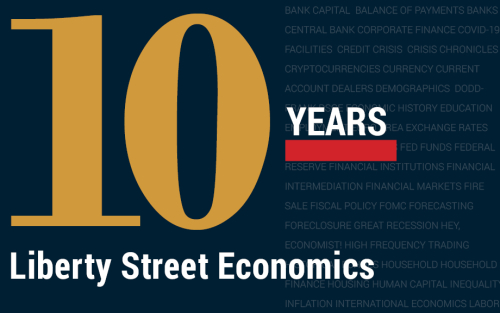The New York Fed DSGE Model Forecast—March 2021
This post presents an update of the economic forecasts generated by the Federal Reserve Bank of New York’s dynamic stochastic general equilibrium (DSGE) model. The model projects solid growth over the next two years, with core inflation slowly rising toward 2 percent. Uncertainty for both output and inflation forecasts remains large.
Who Pays What First? Debt Prioritization during the COVID Pandemic

Since the depths of the Great Recession, household debt has increased from a low of $11 trillion in 2013 to more than $14 trillion in 2020 (see the New York Fed Household Debt and Credit Report). In this post, we examine how consumers’ repayment priorities have evolved over that time. Specifically, we seek to answer the following question: When consumers repay some but not all of their loans, which types do they choose to keep paying and which do they fall behind on?
Reasonable Seasonals? Seasonal Echoes in Economic Data after COVID‑19

Seasonal adjustment is a key statistical procedure underlying the creation of many economic series. Large economic shocks, such as the 2007-09 downturn, can generate lasting seasonal echoes in subsequent data. In this Liberty Street Economics post, we discuss the prospects for these echo effects after last year’s sharp economic contraction by focusing on the payroll employment series published by the U.S. Bureau of Labor Statistics (BLS). We note that seasonal echoes may lead the official numbers to overstate actual changes in payroll employment modestly between March and July of this year after which distortions flip the other way.
Did Dealers Fail to Make Markets during the Pandemic?
Sarkar and coauthors liquidity provision by dealers in several important financial markets during the COVID-19 pandemic: how much was provided, possible causes of any shortfalls, and the effects of the Federal Reserve’s actions to support the economy.
The Persistent Compression of the Breakeven Inflation Curve
Breakeven inflation, defined as the difference in the yield of a nominal Treasury security and a Treasury inflation protected security (TIPS) of the same maturity, is closely watched by market participants and policymakers alike. Breakeven inflation rates provide a signal about the expected path of inflation as perceived by market participants although they are also affected by risk and liquidity premia. In this post, we scrutinize the dynamics of breakeven inflation, highlighting some intriguing behavior which has persisted for a number of years and even through the pandemic. In particular, we document a substantial downward shift in the level of breakeven inflation as well as a marked flattening of the breakeven inflation curve.
Looking Back at 10 Years of Liberty Street Economics
Will Capital Flows through Global Banks Support Economic Recovery?
Liberty Street Economics authors ask whether, based on precedent, global banks are likely to provide additional support to the economic recovery following COVID-19 in the locations they serve.











 RSS Feed
RSS Feed Follow Liberty Street Economics
Follow Liberty Street Economics